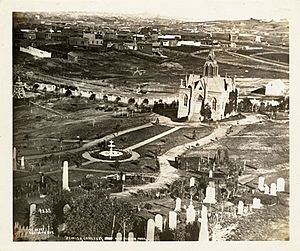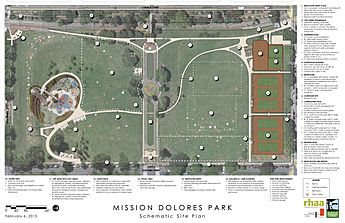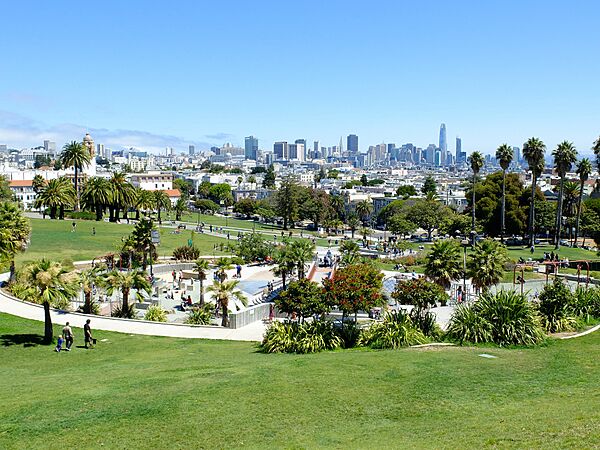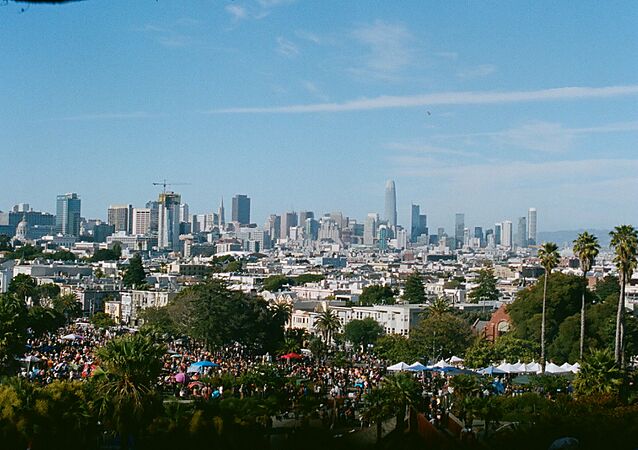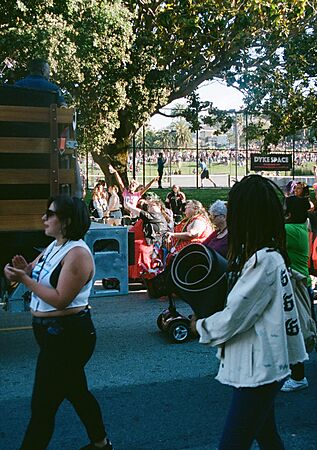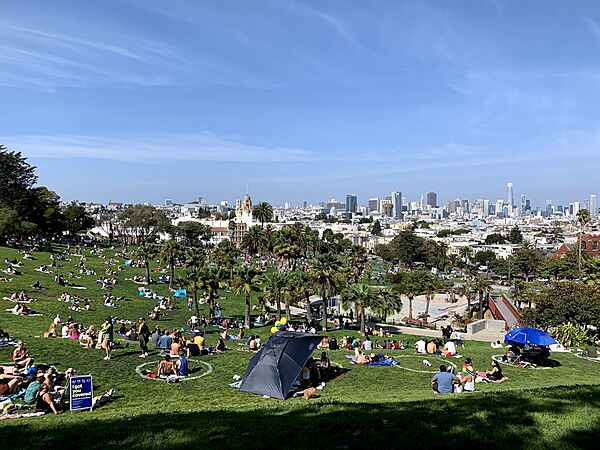Mission Dolores Park facts for kids
Quick facts for kids Mission Dolores Park |
|
|---|---|

View from the park
|
|
| Lua error in Module:Location_map at line 420: attempt to index field 'wikibase' (a nil value). | |
| Type | Municipal |
| Location | San Francisco |
| Area | 15.94 acres (6.45 ha) |
| Established | 1906 |
| Operated by | San Francisco Recreation & Parks Department |
| Open | 6am to 10pm daily |
Mission Dolores Park, often called Dolores Park, is a popular city park in San Francisco, California. It is located near Mission Dolores at the edge of the Mission District.
Dolores Park is surrounded by 18th Street to the north, 20th Street to the south, Dolores Street to the east, and Church Street to the west. Mission High School is right across from the park's northern end. The park is surrounded by homes. South of the park is a hilly area called "Dolores Heights," and The Castro neighborhood is a short walk to the west. The park slopes from southwest to northeast, giving amazing views of downtown San Francisco, especially from the southwest corner.
The park is located east of Twin Peaks in a warm, sunny area. This area was even named one of the "coolest neighborhoods" in the world in 2016. Many people visit the park for outdoor fun. On a sunny weekend day in 2016, between 7,000 and 10,000 people would visit!
Contents
Park History: From Cemetery to Community Hub
Before Spanish missionaries arrived, Native Americans from the Yelamu tribe lived in this area. The nearby Mission Dolores was founded in 1776.
The land where the park now sits used to be a Jewish cemetery. It was owned by two groups, Congregation Sherith Israel and Congregation Emanu-El. The cemetery was no longer used after 1894. The graves were later moved to Colma in San Mateo County. This happened because land in San Francisco became very valuable, and burying people within the city limits was not allowed anymore. The graves are still in Colma today at Hills of Eternity and Home of Peace Cemeteries.
In 1903, over 1,000 property owners in San Francisco wanted to buy the old cemetery land and turn it into a park. They voted on the idea, and it passed with 73.9% of the votes! This started the creation of what was then called "Mission Park." In 1905, the City of San Francisco bought the land for about $291,350.
After the terrible 1906 San Francisco earthquake and fire, the park became a safe place. From 1906 to 1907, it served as a camp for over 1,600 families who lost their homes. Camp life ended in the summer of 1908. Some people even kept their temporary shelters as homes, and a few can still be seen in San Francisco today. In 1917, the J-Church streetcar line, which runs along one side of the park, started its service.
Cultural Connections and Park Renovations
For many years, the Mission District was home to European Americans. From the 1950s to the 1970s, many Latino immigrants moved to the area. To show this change, a copy of the "Mexican Liberty Bell" was placed in the park on September 16, 1966. This bell was a gift from Mexican president Gustavo Díaz Ordaz. It was placed near a statue of Miguel Hidalgo, who is known as the father of Mexican independence. The original "Mexican Liberty Bell" is a church bell that Hidalgo rang in 1810 in Mexico. This event, known as the "Cry of Dolores", started the Mexican War of Independence. In 2014, the replica bell in the park was moved a bit during park renovations.
Over the years, the park also became popular with young people and those working in tech companies. In 2009, a local newspaper noted that the park brings together many different groups of people in San Francisco.
In March 2014, the San Francisco Recreation & Park Department started a big renovation project. It cost $20.5 million and was funded by a bond from 2008. Local community members, neighbors, and city departments all helped plan the improvements. The park fully reopened in January 2016 with a special event. To help keep the park clean, a "LoveDolores" campaign was started. It encourages park users to "pack it in, pack it out," meaning to take their trash with them.
A study in 2011 found that over time, "Mission Park" slowly became known as "Dolores Park." This was likely because of its connection to both Mission Dolores and Dolores Street. Today, its official name is "Mission Dolores Park."
Park Features and Activities
Dolores Park has many things to do! It has six tennis courts, a multi-use court, a basketball court, and a sports field for soccer. There's also a children's playground and two areas where dogs can play off-leash. The southern part of the park offers amazing views of the Mission district, downtown San Francisco, the San Francisco Bay, and the East Bay.
The Muni Metro J-Church streetcar line runs right through the park along its western side. You can get off at the Church and 18th Street and Right Of Way/20th St stations.
The park has been a central place for cultural, political, and sports events since the 1960s. It has hosted political gatherings, festivals, Aztec ceremonial dances, Cinco de Mayo celebrations, and performances by the San Francisco Mime Troupe.
In spring 2012, the new Helen Diller Playground opened in the park. It has two big slides, two swing sets, a granite climbing structure, a sand box, and climbing nets. The playground is designed so that children with disabilities can also enjoy it. The park upgrades, which cost over $20 million, also included adding more public restrooms to help keep the park clean.
Images for kids
-
A panoramic view of Dolores Park, from the Muni stop near Twentieth and Church Streets, with the San Francisco skyline in the distance.
-
Dolores Park in September 2020 during the COVID-19 pandemic with circles for social distancing


